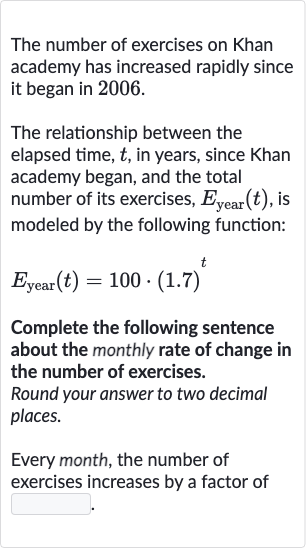AI tutor
Welcome to Bytelearn!
Let’s check out your problem:

The number of exercises on Khan academy has increased rapidly since it began in .The relationship between the elapsed time, , in years, since Khan academy began, and the total number of its exercises, , is modeled by the following function:Complete the following sentence about the monthly rate of change in the number of exercises.Round your answer to two decimal places.Every month, the number of exercises increases by a factor of
Full solution
Q. The number of exercises on Khan academy has increased rapidly since it began in .The relationship between the elapsed time, , in years, since Khan academy began, and the total number of its exercises, , is modeled by the following function:Complete the following sentence about the monthly rate of change in the number of exercises.Round your answer to two decimal places.Every month, the number of exercises increases by a factor of
- Understand the function: Understand the given function.The function represents the total number of exercises as a function of time in years since Khan Academy began. The base of the exponent, , represents the annual growth factor.
- Convert to monthly growth factor: Convert the annual growth factor to a monthly growth factor.Since there are months in a year, we need to find the th root of to determine the monthly growth factor.Monthly growth factor =
- Calculate monthly growth factor: Calculate the monthly growth factor.Using a calculator, we find the th root of .
- Round monthly growth factor: Round the monthly growth factor to two decimal places.Rounded monthly growth factor
- Complete the sentence: Complete the sentence with the calculated monthly growth factor.Every month, the number of exercises increases by a factor of approximately .
